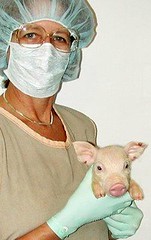Our colleagues at the National Museum of Health and Medicine (in DC) are right now experiencing a dramatically increasing traffic from all over the world to their unofficial Repository of Bottled Monsters blog. From about 100 views a day to 300 views an hour last week.
The reason for this stunning outreach success is that Wired.com and many other websites have spread the news about the NMHM staff’s work to put the museum’s picture archive on Flickr. In a few week’s time, more than half a million Flickr users have seen the exquisite collection of images, especially of American war medicine.
The US Army (which owns NMHM) are imposing a general ban on letting its employees and institutions have access to Flickr (and other social network sites), so the NMHM staff decided to put the pictures on Flickr from their home computers in their spare time.
Many other institutions already do this (in their working hours :-). For example the Smithsonian has a great photostream on Flickr Commons. So do Powerhouse, the National Galleries of Scotland, the Swedish National Heritage Board (two weeks ago), and many others. But what the NMHM example shows better than these is that a presence on the Commons can make a small institution and its blog blossom.
Here at Medical Museion we have so far been somewhat reluctant to think in these terms, not only because it’s a big and expensive operation to put our rich image archive online, but also because we are already getting some direly needed income from selling images.
But maybe we should put the image collection online for free? We will miss a few thousand DKK a year in monetary revenues, that’s right. But the good-will revenue from posting them in the public space, for example, under a Creative Commons license, will probably be much higher — and in the long run it might, as a side-effect, increase our overall revenues.






 In an interview for the Danish daily Information about his new book
In an interview for the Danish daily Information about his new book  Research animals in the history of 20th century biomedicine has received quite a lot of attention in recent years. And what animal is more interesting than the pig! Our colleagues in Health Services Research Unit here in Copenhagen are announcing a three-year position as PhD-student in a new research project, headed by
Research animals in the history of 20th century biomedicine has received quite a lot of attention in recent years. And what animal is more interesting than the pig! Our colleagues in Health Services Research Unit here in Copenhagen are announcing a three-year position as PhD-student in a new research project, headed by 